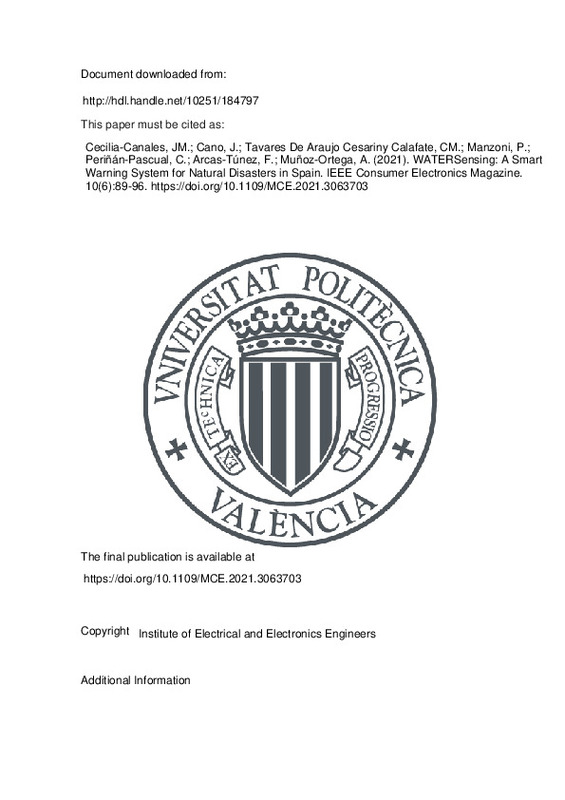Cecilia-Canales, JM.; Cano, J.; Tavares De Araujo Cesariny Calafate, CM.; Manzoni, P.; Periñán-Pascual, C.; Arcas-Túnez, F.; Muñoz-Ortega, A. (2021). WATERSensing: A Smart Warning System for Natural Disasters in Spain. IEEE Consumer Electronics Magazine. 10(6):89-96. https://doi.org/10.1109/MCE.2021.3063703
Por favor, use este identificador para citar o enlazar este ítem: http://hdl.handle.net/10251/184797
|
Título:
|
WATERSensing: A Smart Warning System for Natural Disasters in Spain
|
|
Autor:
|

 Cecilia-Canales, José María
Cecilia-Canales, José María

 Cano, Juan-Carlos
Cano, Juan-Carlos

 Tavares De Araujo Cesariny Calafate, Carlos Miguel
Tavares De Araujo Cesariny Calafate, Carlos Miguel

 Manzoni, Pietro
Manzoni, Pietro

 Periñán-Pascual, Carlos
Arcas-Túnez, Francisco
Muñoz-Ortega, Andrés
Periñán-Pascual, Carlos
Arcas-Túnez, Francisco
Muñoz-Ortega, Andrés
|
|
Entidad UPV:
|
Universitat Politècnica de València. Departamento de Informática de Sistemas y Computadores - Departament d'Informàtica de Sistemes i Computadors
Universitat Politècnica de València. Departamento de Lingüística Aplicada - Departament de Lingüística Aplicada
|
|
Fecha difusión:
|
|
|
Resumen:
|
[EN] Floods are expected to increase in the coming years due to global warming. The early identification of water-based disasters can be lifesaving, and the challenge is to identify appropriate and timely warning measures. ...[+]
[EN] Floods are expected to increase in the coming years due to global warming. The early identification of water-based disasters can be lifesaving, and the challenge is to identify appropriate and timely warning measures. Social-media tools such as Twitter provide citizens with a real-time communication channel for reporting problems related to our environment, which allows humans to act as social sensors. In this article, we show the main results and lessons learned from the research project WATERoT, funded by the Spanish government. In this project, we designed a social sensing application (called WATERSensing) for the prevention and evaluation of water-related disasters with the participation of individuals through social networks. This tool crawls microtexts from different social networks such as Twitter, RSS feeds, or Telegram, which are analyzed with natural language processing techniques. A case study of Storm Gloria, a Mediterranean storm that heavily affected eastern Spain in January 2020, is presented to evidence that the system can correlate data from social media with actual events. We demonstrate that the analysis of different sources of information opens up new opportunities in the development of warning systems for the prevention, early identification, and management of natural disasters.
[-]
|
|
Palabras clave:
|
Social networking
,
Blogs
,
Sensors
,
Real-time systems
,
Consumer electronics
,
Manganese
,
Tools
|
|
Derechos de uso:
|
Reserva de todos los derechos
|
|
Fuente:
|
IEEE Consumer Electronics Magazine. (issn:
2162-2248
)
|
|
DOI:
|
10.1109/MCE.2021.3063703
|
|
Editorial:
|
Institute of Electrical and Electronics Engineers
|
|
Versión del editor:
|
https://doi.org/10.1109/MCE.2021.3063703
|
|
Código del Proyecto:
|
info:eu-repo/grantAgreement/f SéNeCa//20813%2FPI%2F18/
...[+]
info:eu-repo/grantAgreement/f SéNeCa//20813%2FPI%2F18/
info:eu-repo/grantAgreement/AEI/Plan Estatal de Investigación Científica y Técnica y de Innovación 2017-2020/RTI2018-096384-B-I00/ES/SOLUCIONES PARA UNA GESTION EFICIENTE DEL TRAFICO VEHICULAR BASADAS EN SISTEMAS Y SERVICIOS EN RED/
info:eu-repo/grantAgreement/EC/H2020/101017861/EU
info:eu-repo/grantAgreement/AGENCIA ESTATAL DE INVESTIGACION//RTC-2017-6389-5-AR//PLANIFICACIÓN Y GESTIÓN DE RECURSOS HÍDRICOS A PARTIR DE ANÁLISIS DE DATOS DE IOT/
info:eu-repo/grantAgreement/AGENCIA ESTATAL DE INVESTIGACION//RYC2018-025580-I//AYUDA CONTRATO RAMON Y CAJAL-CECILIA CANALES/
info:eu-repo/grantAgreement/AGENCIA ESTATAL DE INVESTIGACION//RTC2019-007159-5//DESARROLLO DE INFRAESTRUCTURAS IOT DE ALTAS PRESTACIONES CONTRA EL CAMBIO CLIMÁTICO BASADAS EN INTELIGENCIA ARTIFICIAL/
[-]
|
|
Agradecimientos:
|
This work was supported in part by the Spanish Ministry of Science and Innovation under Grant RYC2018-025580-I, Grant RTI2018-096384-B-I00, Grant RTC-2017-6389-5, and Grant RTC2019007159-5; in part by the Fundacion Seneca ...[+]
This work was supported in part by the Spanish Ministry of Science and Innovation under Grant RYC2018-025580-I, Grant RTI2018-096384-B-I00, Grant RTC-2017-6389-5, and Grant RTC2019007159-5; in part by the Fundacion Seneca del Centro de Coordinacion de la Investigacion de la Region de Murcia under Project 20813/PI/18; and in part by the European Union's Horizon 2020 Research and Innovation Programme under Grant 101017861.
[-]
|
|
Tipo:
|
Artículo
|







![[Cerrado]](/themes/UPV/images/candado.png)


